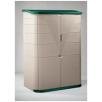Jerry,
Another option is to store the combustible and flammable liquids inside of a flammable liquids cabinet inside of the barn, far away from welding, at least 30 feet by code.
The following is from NFPA 30, 2003 Flammable & Combustible Liquids Code. As far as venting the cabinet is concerned see section 6.3.4 below, regardless of what you do. If you go with a plastic cabinet I would not put it next to the barn, but at least 10 feet away.
Section 6.3.3
Wooden cabinets constructed in the following manner shall be acceptable:
(a) The bottom, sides, and top shall be constructed of exterior grade plywood that is at least 25 mm (1 in.) thick and of a type that will not break down or delaminate under fire conditions.
(b) All joints shall be rabbetted and shall be fastened in two directions with wood screws. Where more than one door is used, there shall be a rabbetted overlap of not less than 25 mm (1 in.).
(c) Doors shall be equipped with a means of latching and hinges shall be constructed and mounted in such a manner as to not lose their holding capacity when subjected to fire exposure.
(d) A raised sill or pan capable of containing a 50 mm (2 in.) depth of liquid shall be provided at the bottom of the cabinet to retain spilled liquid within the cabinet.
(4) Listed storage cabinets that have been constructed and tested in accordance with 6.3.3(1) shall be acceptable.
6.3.4* The storage cabinet shall not be required by this code to be vented for fire protection purposes, and vent openings shall be sealed with the bungs supplied with the cabinet or with bungs specified by the cabinet manufacturer. However, if the storage cabinet is vented for any reason, the cabinet shall be vented directly to outdoors in such a manner that will not compromise the specified performance of the cabinet and in a manner that is acceptable to the authority having jurisdiction.
A.6.3.4 Venting of storage cabinets has not been demonstrated to be necessary for fire protection purposes. Additionally, venting a cabinet could compromise the ability of the cabinet to adequately protect its contents from involvement in a fire because cabinets are not generally tested with any venting. Therefore, venting of storage cabinets is not recommended.
However, it is recognized that some jurisdictions can require storage cabinets to be vented and that venting can also be desirable for other reasons, such as health and safety. In such cases, the venting system should be installed so as to not affect substantially the desired performance of the cabinet during a fire. Means of accomplishing this can include thermally actuated dampers on the vent openings or sufficiently insulating the vent piping system to prevent the internal temperature of the cabinet from rising above that specified. Any make-up air to the cabinet should also be arranged in a similar manner.
If vented, the cabinet should be vented from the bottom with make-up air supplied to the top. Also, mechanical exhaust ventilation is preferred and should comply with NFPA 91, Standard for Exhaust Systems for Air Conveying of Vapors, Gases, Mists, and Noncombustible Particulate Solids. Manifolding the vents of multiple storage cabinets should be avoided.
6.3.5 Storage cabinets shall be marked in conspicuous lettering:
FLAMMABLE — KEEP FIRE AWAY.
